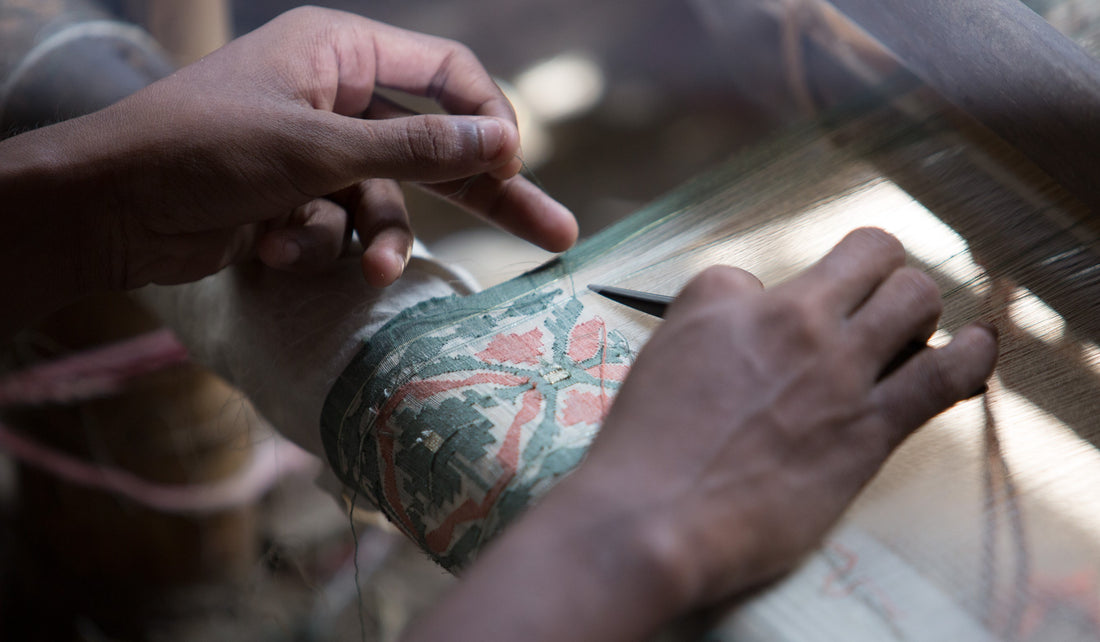
Broken Threads

All images: Jamdani weavers in Bangladesh © Nurun Nahar Nargish, National Crafts Council of Bangladesh
Regular Selvedge contributor Sonia Ashmore reports on fears for the artisan textile community during and following the pandemic: Handloom weaving in India and Bangladesh has long been a fragile profession; it is now threatened by COVID-19. As the subcontinent has locked down, hundreds of thousands of weavers, participants in a complex web of production and distribution, are left helpless, cashless and fearing starvation. Lack of materials, unsold stocks made for usually booming seasonal festivals and weddings, and frozen local and international markets, are spoken of as ‘nails in the coffin’ of handloom.

In the informal economy, skilled weavers, spinners, dyers, block printers and embroiderers, already among the lowest paid workers in the subcontinent -many earning less than £50 a month- are often uncounted, lacking social security, debt-burdened, with no access to credit except unrepayable loans. In Bangladesh 97% of weavers surveyed recently were unable to buy protein food for their families; the National Craft Council and Bengal Craft Society with the support of BRAC are raising funds for weaving communities whose skills were celebrated at last year’s Jamdani Festival (Selvedge Issue 93: Rethink). Here and in India state hand-outs of food and cash are erratic; civil society and NGOs are left to do their best.

Organisations such as Tata Trust’s Antaran seek to support weavers and find sales for their stocks. Delhi based Dastkar helps craftspeople with immediate assistance and marketing, encouraging the public to ‘Buy – Not Donate’. Designer retailer Weavers’ Studio Kolkata supports its weavers with food grains, medical expenses, advances and guaranteed paid work. Indian fashion designers Rahul Mishra, Palak Shah of Ekaya and others are supporting their weavers and handcraft workers, recognising the interdependence of couture and craft. None have unlimited funds.
Some NGOs suggest that the crisis could provide an opportunity for capacity building, rethinking models of production and marketing and supporting craft communities through technology and social media. But people need to eat before they can weave. As Weavers’ Studio comments, ‘the thak … thak of the hand-operated looms, the stamping of wooden blocks, the soft murmurs of women working on tie and dye patterns and the constant whirr of tailoring machines, it’s all now replaced by a fear of silence. It’s all gone cold.’ What is at stake is life, livelihoods, community and the great, threatened, pool of astonishing skills that have made South Asian textiles a marvel of the world.
Ways to help: The key message is to keep buying if and where you can; visit the following organisations for more information Artisan Relief Fund, Dastkar appeal, Antaran Artisan Connect, Rehwa Society and Chitrika.
The Selvedge World Fair in September will provide an opportunity to buy direct from artisans and makers (online).

1 comment
Very good initiative. Handloom weavers require support, directly and without going through the trickle down process, that has often let them down. As everywhere, production and supply chain models that link handloom weavers with national and international customers need to change, reversing the flow of benefits. Going what is being taken up as a slogan in food, clothing also requires to pick up a objective that celebrates local production for local consumption and linking producer with the consumer directly.